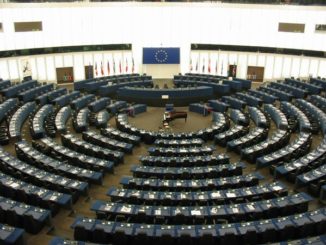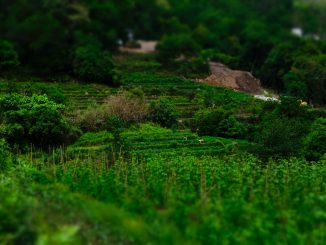The Transatlantic Trade and Investment Partnership (TTIP) talks have revealed a contentious debate over local food names, so-called Geographical Indications (GIs). Far from a technical issue, the differing approaches to protections for local food names underscore very different traditions. Karen Hansen-Kuhn and Hannes Lorenzen unpack the issues in this long read.

Historically, European farmers have sought to protect names and processes for certain food products associated with a specific local food culture. GIs were originally a tool used by disadvantaged regions to protect their specific products and receive a premium price for unique, and sometimes difficult natural conditions of production, especially in mountain areas. It has been seen as a tool to keep a higher added value in a specific region and to create closer connections with consumers through clear rules for quality production.
To many Americans, this might sound like an obscure, new issue or appear as a trick of European negotiators to impose barriers in trade. Reports on EU demands to protect what most Americans would consider common food names such as “feta” have elicited surprised and rather derisive comments among Members of Congress and the media. On the other hand, some U.S. local producers of cheeses and specialty goods who are creating their own new traditions, are supportive of this approach and seek to enhance inadequate trademark protections in the U.S.
In each case, the foundation for this approach has been the protection of local markets and local traditions against an outside corporate takeover. In this age of globalization, however, the debate becomes a bit murkier. If EU negotiators use GI protections around the world to create new export opportunities, it seems likely that the drive to expand production to sell to those new markets will undermine the very nature of GIs in Europe itself and result in greater corporate control and fewer connections to local landscapes and traditions. What is more: the quality of those special goods will suffer.
Some historical perspective
Protections for Geographical Indications have existed for more than a century. The Paris Convention for the Protection of Industrial Property of 1883 (Paris Convention) established protections for industrial and agricultural goods with a view toward protecting producers’ intellectual property. While there was much less trade than today, diplomats at the time were concerned about protections for their citizens’ products at international trade fairs. That accord was followed by the Madrid Agreement for the Repression of False or Deceptive Indications of Source on Goods of 1891 and the Lisbon Agreement for the Protection of Appellations of Origin and their International Registration of 1958. (1)
The World Trade Organization (WTO) Agreement on Trade Related Aspects of Intellectual Property Rights (TRIPS) includes a special section on the protection of GIs. Article 22.1 of the TRIPS Agreement defines GIs and establishes that Members have a duty to prevent deceptive uses of product names through trademark or other intellectual property protections.
The central idea behind protections for GIs is that these products have inherent qualities related to their place of production (such as soil or climatic conditions, called terroir), as well as cultural knowledge and traditions, that differentiate them from similar products. That designation creates a kind of place-based “brand” that informs consumers about their special qualities and often allows producers to charge a premium price. GIs are most common for wines, cheeses and certain meats, but there are also some GIs for certain kinds of textiles (such as Thai Silk) or Swiss Watches produced according to specific criteria. (2)
Unlike other forms of intellectual property, protections for GIs are not held by specific companies or individuals. As opposed to trademarks, which are owned by a particular company or trade association, GIs are a collective initiative and right. They cannot be bought, sold or assigned to other rights holders.
These protections are most advanced in the European Union, which has established a process to register and protect GIs. In each case, producers apply to register a product using specific production, processing and geographic standards. Those decisions are made first at the regional and then at the national level, although non-EU applicants may also apply directly to the European Commission.
The EU has separate registration and protection regimes for wines, spirits, and agricultural and food products. As of May 2014, 1226 food and agricultural products were registered at the European Commission as protected products. Those products include meats and meat products, cheeses, beers, fruits and flowers. They are produced and marketed locally or regionally, but some categories, especially cheeses, are widely exported as well. The list includes 216 cheeses, among them Gruyere, Roquefort, Queso Manchego, Mozzarella di Bufala, Camembert de Normandie, Neufchatel, Fontina, Gorgonzola, Asiago, Pecorino Romano, Gouda Holland, Edam Holland and Feta. It is important to note that in some cases, it is the compound name, such as Parmigiano Reggiano, that is protected, rather than the broader category of parmesan cheese. (3)
Geographical Indications in the trade debate
In 2006, the U.S. and EU reached a bilateral agreement on the protection of wines. That agreement requires the U.S. to make changes in laws to limit the use of certain wine names considered “semi generic”: Burgundy; Chablis; Champagne; Chianti; Claret; Haut Sauterne; Hock; Madeira; Malaga; Marsala; Moselle; Port; Retsina; Rhine; Sauterne; Sherry and Tokay. (4) Existing producers of these wines would be “grandfathered” in, but non-EU producers not meeting the GI criteria for those wines would not be allowed to use those names. The EU has a similar bilateral agreement on wine with Australia, and agreements on wine and spirits with Canada, Mexico, Chile and South Africa. On the 14 of January 2015 an agreement between the EU and Morocco was finalized. It provides direct protection to more than 3,200 EU GI names in Morocco and 30 Moroccan GIs in the EU (names registered until 15 January 2013, which is to be considered the cut-off date. (5) There are no indications that traditional producers of goods protected by GIs in the various regions of the EU are seeking to increase exports of their products to third countries. On the contrary, in some cases there have been initiatives of producers to voluntarily limit production in order not to undermine the quality of products. Certain cheese producers like Compté or Beaufort in South France have set limits for production through specific agro-environmental rules and limits for carrying capacity for cattle. (6)
However, EU trade negotiators have been seeking to use geographical indications in the negotiation of bilateral free trade agreements to expand trade – and thereby undermine the original intentions of GIs. New commitments on the issue were reached in FTAs with Peru and Colombia, Central America, and Korea. In May, former EU Trade Commissioner Karel De Gucht told a United Kingdom House of Lords subcommittee hearing on TTIP that, without securing at least partial protection for EU GIs in the United States, it would be very difficult to conclude a deal on agriculture. According to a report in Inside U.S. Trade, the EU is seeking GI protections for a list of 200 items, including meats, fruits and vegetables, wines and spirits, and 75 kinds of cheese. (7) While the idea of promoting GIs as a tool to protect a diversity of food traditions and quality is a good one, the push for GIs as a better kind of trademark enshrined within trade law seems to undermine the very basic idea.
There is no public information yet on the exact list of GI protections the EU will seek in TTIP, but an examination of the commitments made in other recent trade agreement could give some indications. The trade agreements negotiated between the EU and Central America, Peru-Colombia, and South Korea all protect such cheese names as Camembert de Normandie, Feta, Gorgonzola, Parmigiano Reggiano, Roquefort and Taleggio. (8)
The EU-Canada Comprehensive Economic and Trade Agreement (CETA), which was concluded in 2014, lists protections for 173 European food names for products sold in Canada. The governments would take action to prevent the use of a GI unless they are produced according to specific standards and from the specific countries identified in the Annex, even when the product is identified as being from Canada. Certain cheese names that many would consider common names have more limited protections, at least for now. Under Articles 7.6.1 and 7.6.2, companies that were selling Asiago, Feta, Fontina, Gorgonzola and Munster before October 18, 2013 can continue to use those names, but new entrants to the Canadian market will be required to add qualifiers such as “kind”, “type”, “style” or “imitation”.
While the details of the EU’s specific negotiating objectives on GIs in TTIP are not clear, it is a priority area in the negotiations. The EU Council’s Directive for the TTIP negotiations outlines main negotiating objectives for the agreement. The only specific issue identified in the section on intellectual property rights is a mention of GIs.
The debate on GIs in the United States
While this concept is most developed in the EU, there are a number of Geographical Indications already in use in the United States. Although there is no centralized list as in the EU, names such as Maine Lobsters, Idaho Potatoes, Vidalia Onions, Kona Coffee and Florida Oranges are protected under trademarks held by industry associations. The American Origin Products Research Association, an organization established to promote the establishment and protection of GIs in the United States, argues that increased designation and protection of GIs for locally produced cheeses and other goods would enhance value added for local producers and provide more accurate and useful information to consumers. They argue that existing trademark law puts the burden of protection on those industry associations, raising unfair obstacles to producers of locally established products to establish their own place-based names for cheeses and other products.
Those concerns have found some resonance among local producers. In an article in the Portland Press Herald, Caitlin Hunter, a cheese maker at Appleton Creamery in Maine said, “I completely agree with the Europeans that we should not use their cheese names. They have spent centuries developing their distinctive regional styles, and we should not steal them, or try to reproduce them.” She labels her cheese “Camdenbert,” (a takeoff on the coastal town Camden) for example. However, she argues that extending those protections to what most would regard as generic names is another matter. (9)
The Consortium for Common Food Names, an industry association, (CCFN) argues that the EU’s agenda on GIs would unfairly restrict food names that are no longer strictly associated with particular regions. It argues for a process to establish which food names are actually in common usage, perhaps with a registry at the international level. It further suggests requiring that GIs include the name of the place where the good is produced, i.e., Camembert de Normandie (which is the actual GI approved by the EU) rather than simply Camembert (which, in fact, the EU has not sought to protect).
These issues have found support in Congress, where two letters to the U.S. Trade Representative (USTR) have rejected the EU’s push for GI protections in TTIP. In an April 4, 2014 letter to USDA Secretary Tom Vilsack and USTR Michael Froman, 45 Senators rejected the EU’s approach on GIs in TTIP, focusing on protections for processed meat names such as bologna. They called on USTR to work aggressively to ensure that the EU’s approach on GIs does not impair the ability of U.S. businesses to compete, stating, “We are concerned that these restrictions would impact smaller businesses who specialize in artisan and other specialty meat products such as bratwurst, kielbasa, wiener schnitzel and various sausages.” (10) The EU does not actually recognize GIs for any of those terms as single meat names. According to the European Commission’s Database of Origin and Registration (DOOR), it does recognize Mortadella Bologna, Thüringer Rostbratwurst, Nürnberger Bratwürste, Nürnberger Rostbratwürste and Kiełbasa lisiecka.
That letter was followed in May by a letter from 177 members of the House of Representativesfocused on GIs for cheese names. That letter, led by the Congressional Dairy Farmers Caucus with support from the National Milk Producers Federation, asserts that, “The EU is taking a mechanism that was created to protect consumers against misleading information and instead using it to carve out exclusive market access for its own producers. The EU’s abuse of GIs threatens U.S. sales and exports of a number of U.S. agricultural products, but pose a particular concern to the use of dairy terms.” (11)
Back to basics: protecting GIs for local economies and sustainable food chains
Fundamentally, protections for Geographical Indications should ensure consumers’ right to know how and where their food was produced, while enhancing local producers’ rights to livelihoods and cultural traditions. Extending these kinds of protections to local producers in the U.S. or other trading partners, with strong governmental support, could be an element that would help to rebuild connections among local consumers, farmers and natural environments.
On the other hand, bolstering those protections to facilitate unlimited expansion of production in foreign markets seems a sure recipe for corporate control and industrial-scale production. GIs should not become the premium trademark of the global food industry. As a collective initiative of producers defining agro-ecological rules for sustainable use of local resources which enhance the production of a great variety of quality food, decent jobs in rural areas and a fair income for farmers in disadvantaged areas, GIs should consciously put cooperation between farmers and consumers before competition on international markets and food quality before growth in market shares.
Two cases of GIs for cheese from the South East of France may illustrate how European producers, mainly in disadvantaged rural regions, have developed such a strategy to defend a fair income for farmers, to preserve and develop sustainable farming practices in ecologically sensitive areas, and to offer a high quality product to consumers which also attracts attention or interest in visiting that region as a tourist.
The raw milk cheese “Beaufort” is produced in the mountain region of Savoie. The Geographical Indication was registered in 1968 and the EU accepted an EU AOC label in 2009. The GI is carried by 600 milk farmers, 4 processors and 47 cheese agers. The annual production is around 4000 tons of cheese which ripens in 8 -15 months. The cooperatives sell two seasonal cheeses: summer and winter cheese. Milk for summer cheese is collected between June and October in the higher parts of the mountains where cows are taken to graze the steep slopes. It receives a higher price for a special taste. Farmers are not allowed to use any artificial fertilizer or feed which does not stem from the region. Only hay, not silage, is allowed for winter feed.Cows must have at least one hectare of grazing area and must be one of seven local cattle races which is adapted to the climate and mountain conditions.
The region profits from this local product as tourists come for the beauty of the cultivated landscape as well as for the specific products like Beaufort Cheese and others. Farmers receive a premium price not only for the name, but for the sustainable practices and the good raw milk they deliver to the processors. The region keeps young people, because there are jobs available in a highly integrated rural community.
The case of Compté cheese in the Jura area of southern Franceis similar, but has reached a bigger size of production. Compte has an annual production of 40,000 tons of cheese, which is also exported to other member states of the EU. However, similar limitations on fertilizer use, the exclusion of GMOs and a clear link to the carrying capacity of the land is obligatory for all producers.
A different case is Feta cheese, which has no regional limitation and is considered by most registered GI holders as the bad case of the story. Feta cheese was originally produced in Greece by small farmers from sheep milk using a special recipe for soft cheese with a longer shelf life due to added salt. This cheese did not receive unchallenged GI protection until 2006. During the period of the great surplus production of milk in Europe in the 1970s and 80s, many large dairy industries in Denmark, Germany and the Netherlands started imitating Feta, even produced from cow milk and sold it as Feta. Only upon the initiative of large Greek Feta industries in 1996, was Feta recognized as a GI. Some member states then appealed to the European Court for the annulment of this decision. Their position was that the name Feta had become a common one. The European Court decided the partial annulment, removing the name Feta from the protected geographical indication register. The thinking behind this decision was that during establishment of Feta as GI, the Commission had not taken into account the analysis of the situation in other member states regarding the documentation of the authenticity of its origin.
In 2001, the Commission suggested the re-registration of Feta in the rule (ΕC) 1107/96. The name Feta was re-introduced in the GI registry with the (EC) 1829/2002 ruling of the Commission in October of 2002.
These three cases differ in some fundamental aspects. The production of Beaufort and Compte cheeses are integrally linked to local cultures, environments and economies. In many ways they epitomize the ideal of re-localization of food. While their GI designation rightfully protects their use within the EU from imported products using those names, their designation as export commodities included in free trade agreements risks losing their essential character.
Exactly where one draws the line between a product that is truly linked to local economies and traditions and one that has become more of a large scale commodity for export is perhaps difficult to draw. But it would seem best suited to an open process involving all stakeholders. U.S. producers of local cheeses, wines and other products would also welcome a dialogue that would enhance the limited protections they enjoy under U.S. law. While this might be possible to achieve through a process of bilateral consultations, it is hard to imagine how it could occur within the black box of negotiations for TTIP.
Karen Hansen Khun is Director for international Strategies of the Institute for Agriculture and Trade Policy (IATP) based in Washington, DC
Hannes Lorenzen is senior advisor at the Committee for Agriculture and Rural Development of the European Parliament in Brussels and is a co-founder of the Agriculture and Rural Convention Arc2020.
[1]World Intellectual Property Organization, Geographical Indications: An Introduction, WPO Publication No. 952(E), p. 6-7.
[2] WIPO, p. 11.
[3] EC Database of Origin and Registration, http://ow.ly/J5Ro3
[4] O’Conner and Company, Geographical indications and TRIPs: 10 Years Later… A roadmap for EU GI holders to get protection in other WTO Members, p. 11.
[5]Commission press release 14 January 2015
[6]http://www.cooperative-de-beaufort.com/ and http://androuet.com/Beaufort-94.html
[7]“TTIP Talks On GIs Focused On Comparing Systems, Not On EU GI List,” Inside U.S. Trade, May 23, 2014.
[8] Source: http://ec.europa.eu/trade/policy/countries-and-regions/agreements/#_other-countries
[9] Whit Richardson, “Europe wants its cheese names back, and some Mainers agree,” Portland Press Herald, April 15, 2014.
[10] Posted at http://www.commonfoodnames.com/the-issue/current-activities/meat-gis-eu-ttip-vilsack-and-froman-april-2014/.
[11] Letter posted at http://www.commonfoodnames.com/wp-content/uploads/House-Dairy-TTIP-Letter1.pdf.





